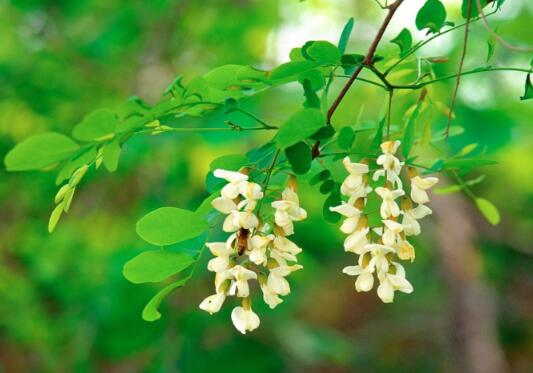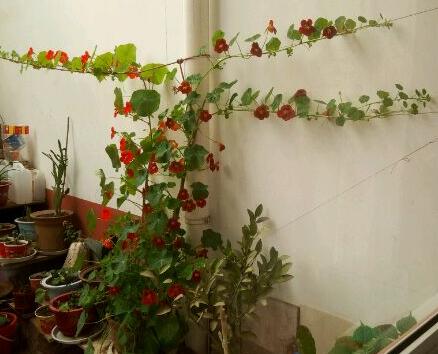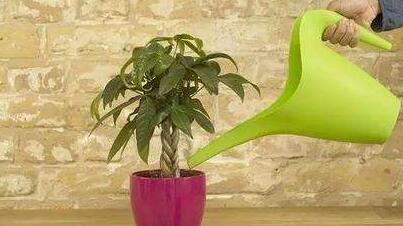How to raise potted Sophora japonica flowers, breeding methods and precautions / sufficient light
Flos Sophorae, also known as Flos Sophorae, is a highly ornamental flower plant, which can be seen in many parts of our country. However, if you want to raise it well, you need to pay attention to a lot of things. So how to grow potted locust flowers? What are the breeding methods and matters needing attention of Sophora japonica? Next, the editor will take you to learn about it.
First, how to raise potted locust flowers and understand their habits

If we want to know how to raise potted locust flowers, we must first understand its growth habits. Sophora japonica is a temperate plant, it likes light, so it needs to keep enough light in the process of culture, so it can grow better. In addition, watering, fertilization and other aspects are also more fastidious, the specific maintenance details are introduced below, let's take a look.
2. Culture methods and matters needing attention of Sophora japonica
1. The soil has better drainage.
If you want to raise locust flowers well, you must choose suitable soil, which is like building a house and laying a foundation, which is a step to lay a good foundation. Sophora japonica is relatively fertile humus soil, this kind of soil drainage is very good, is very suitable for potted Sophora japonica growth.
two。 Fertilize fertilizer, apply thin fertilizer frequently
Fertilizer is one of the main nutrients in the growth process of Sophora japonica. We should apply fertilizer frequently in the process of breeding it, because only with sufficient nutrients can it grow more healthily. However, there is one thing we should pay attention to when fertilizing. Before fertilizing, the fertilizer needs to be diluted with water so that it can be absorbed. If the fertilizer is too thick, it is easy to burn the plant.
3. Watering, avoid stagnant water
In the process of the growth of Sophora japonica, the demand for water is great, so we need to water frequently, especially after entering the summer, because the temperature is high, the water will evaporate too fast, so we basically need watering every day. However, we have to control the amount of water when watering it, do not water too much, otherwise it is easy to cause stagnant water, if stagnant water may cause the phenomenon of rotting roots.
4. Light, avoid strong light
Sophora japonica is a very light-loving plant, so we should keep it in sufficient light in the process of breeding. The light is more suitable in spring and autumn, we can let it receive light all day, and in summer, we can let it receive light in the morning. When the midday light is too strong, we should move it to the indoor half-shade to avoid sunburn.
5. Temperature, not lower than 15 ℃
Potted Sophora japonica is very sensitive to temperature in the process of growth, moderate temperature is the most suitable for planting potted Sophora japonica, if the temperature is lower than 15 ℃ or lower, it is easy to frostbite plants, so when we are breeding, the most important thing is to pay attention to winter heat preservation measures, indoor planting is more appropriate.
6. Timely prevention and control of diseases and insect pests
In the process of cultivating Sophora japonica, if we are not careful enough, it is easy to let diseases and insect pests enter. This kind of problem is very harmful to the plant, and it is easy to cause plant death if we do not deal with it in time. As for the specific treatment methods, you can refer to the article on pest control of Flos Sophorae, which is introduced in detail.
Cultivation skills of potted Sophora japonica
The locust flower must be no stranger to everyone, and it is one of the common plants in everyone's office. There are many ways to plant Sophora japonica, and one can be planted in pots. The picture of potted Sophora japonica shows us the beauty of potted Sophora japonica and has higher ornamental value. Potted locust flowers can clean the air and are very easy to breed. Let's take a look at the cultivation techniques of potted Sophora japonica.
Cultivation skills of potted Sophora japonica
1. Cultivation skills of potted Sophora japonica flowers-- temperature
Potted Sophora japonica is very sensitive to temperature in the process of growth, moderate temperature is the most suitable for planting potted Sophora japonica, if the temperature is lower than 15 degrees or lower, freezing injury will begin to occur. Therefore, the most important thing to plant potted locust flowers is to pay attention to heat preservation measures in winter, indoor planting is more appropriate.
Second, the cultivation skill of potted Sophora japonica-- light.
Potted locust flowers are more suitable for growth in a warm and cool situation, but a semi-shady environment is also necessary, because Sophora japonica is not suitable for direct sunlight. Secondly, when cultivating potted locust flowers, it is best to scatter sunlight, and do not place locust flowers in direct sunlight for a long time.
Third, the cultivation skill of potted Sophora japonica-- moisture.
Potted Sophora japonica flowers need a lot of water for growth, and potted Sophora japonica flowers are cold-resistant but can not lack of water at the same time. Too much water will lead to rotten roots of potted locust flowers, so make sure that the soil can discharge excess water in time after watering. For potted locust flowers, high-temperature water evaporates too quickly in summer, so water should be added frequently.
Culture method and function of Phalaenopsis
Phalaenopsis is a kind of plant suitable for indoor culture, with butterfly-shaped flowers, elegance and elegance, and enjoys the reputation of "queen of orchids". Most Phalaenopsis are produced in humid Asia, which determines the growth characteristics of Phalaenopsis. Must be ventilated, breathable, moderate temperature, high humidity environment can be said to be an excellent environment for breeding Phalaenopsis. Let's learn more about its specific breeding methods and functions. Water Phalaenopsis is an epiphytic orchid whose roots are exposed to the air and can absorb water from the moist air. When artificial cultivation, the root is buried in the cultivation substrate, too much watering, the substrate ventilation will become worse, the fleshy root will rot, so it should be watered with humidity. Temperature family raise Phalaenopsis, first of all to ensure the temperature. Phalaenopsis is native to the tropics and likes the environment of high temperature and humidity. The lowest temperature during the growth period should be kept above 15 ℃. Phalaenopsis grows well when the daytime temperature is 27 ℃ and the night temperature is about 18 ℃. At the turn of autumn, winter and spring, and when the winter temperature is low, attention should be paid to warming rooms with heating equipment in winter, and cooling and ventilation should be paid attention to when the summer temperature is on the high side. Although Phalaenopsis prefers shade, it is still necessary to make the orchid plant accept some light, especially before and after flowering, the appropriate light can make Phalaenopsis blossom earlier, and the flowers are gorgeous and lasting, and should generally be placed indoors where there is scattered light. Do not let the sun shine directly. The principle of fertilization in nutritious cultivation of Phalaenopsis should be less fertilization and light fertilizer. In the normal growing period, 2000 times of orchid special fertilizer was applied to fertilize the roots. depending on the growth, once every 2 weeks to 3 weeks, 15-30-15 water-soluble high-phosphate fertilizer 1000-2000 times before flowering could be sprayed about 10 days, and fertilization should be stopped in flowering and low temperature seasons. The plants that act on Phalaenopsis are very peculiar, with neither stolons nor pseudobulbs. Each tree produces only a few broad leaves as thick as a spoon, stacked alternately on top of the base. The thick white air root is exposed around the leaves, and some cling to the outer wall of the flowerpot, which is very natural and wild. Moreover, Phalaenopsis is a flower blooming during the Spring Festival. In this cold and withering season, why not add a piece of vitality to people's home? its role in beautifying the environment is self-evident. Conclusion: people often say that the more beautiful, the more beautiful things are more toxic and harmful, and Phalaenopsis is just an exception, gorgeous appearance, but it is actually a non-toxic plant, want to choose potted friends, this is a good choice. The above is the breeding method of Phalaenopsis and its function that I bring to you. I hope it can bring some help to the friends who love flowers and cherish flowers. [more] | plants suitable for indoor cultivation | Culture method of Crab claw Orchid | Culture method of wealth tree | efficacy and function of wood incense | except formaldehyde plant | | efficacy and function of Sophora japonica flower | Peony blossom | how to raise rich bamboo in winter | what plant absorbs formaldehyde | evergreen flowers | | Culture method of daffodil | poinsettia culture method | Cyclamen culture method | Hydrangea | Flower culture method | benefit of bayberry | | Happiness tree culture method | efficacy and function of Ganoderma lucidum | effect and function of peppermint | Culture method of Gardenia jasminoides | how to grow orchid | | efficacy and function of mango | efficacy and function of Platycodon grandiflorum | Culture method of money tree | symbolism of lily flower | Fruit preservative |
- Prev

How to climb the vine, top the seedlings / set up brackets / evenly bind / strengthen maintenance
It is well known that the lotus is semi-trailing, so if it is properly maintained, it can climb on the bracket and the wall, of course, if it requires some skills, but how does the lotus climb the vine? When do we need to trim it? And when will the bracket be set up? The editor of Xiaomian will come to answer your questions.
- Next

How often is the bird nest fern watered, and the climate is combined with the growth of flexible watering / additional watering method
In the breeding method of bird nest fern, watering can not only keep the soil moist, but also keep the plant high humidity, which is very important for the growth of bird nest fern, so how to water bird nest fern? How often is the bird's nest fern watered? Next, the editor will tell you the secret of watering.
Related
- Fuxing push coffee new agricultural production and marketing class: lack of small-scale processing plants
- Jujube rice field leisure farm deep ploughing Yilan for five years to create a space for organic food and play
- Nongyu Farm-A trial of organic papaya for brave women with advanced technology
- Four points for attention in the prevention and control of diseases and insect pests of edible fungi
- How to add nutrient solution to Edible Fungi
- Is there any good way to control edible fungus mites?
- Open Inoculation Technology of Edible Fungi
- Is there any clever way to use fertilizer for edible fungus in winter?
- What agents are used to kill the pathogens of edible fungi in the mushroom shed?
- Rapid drying of Edible Fungi

